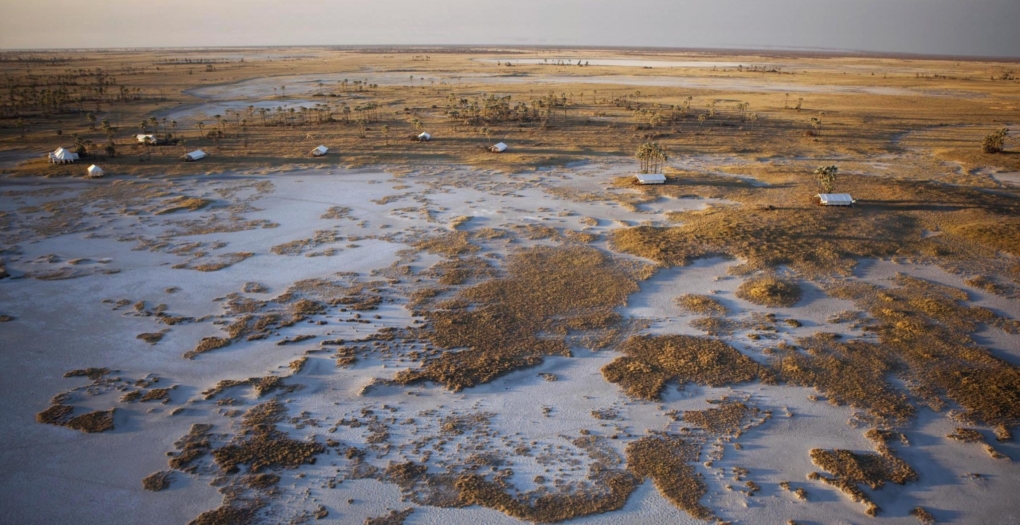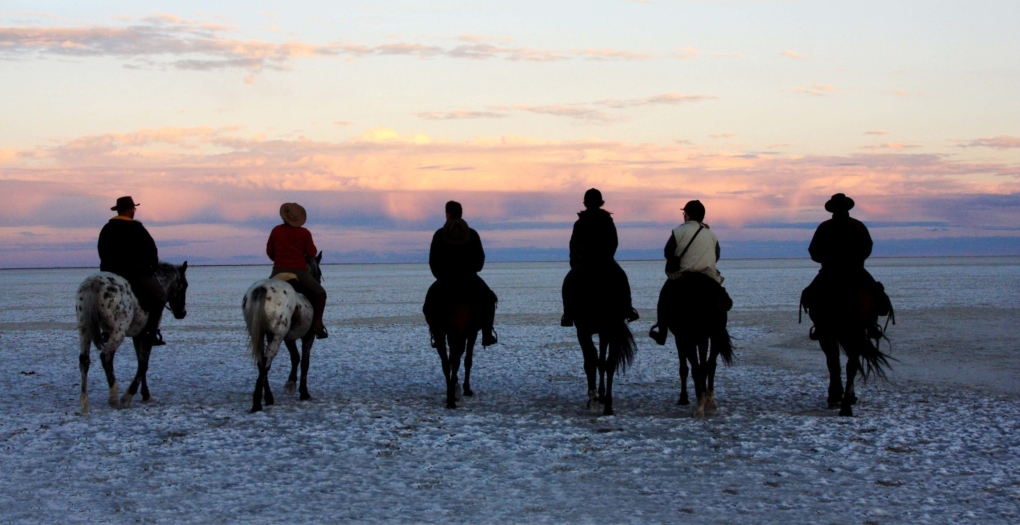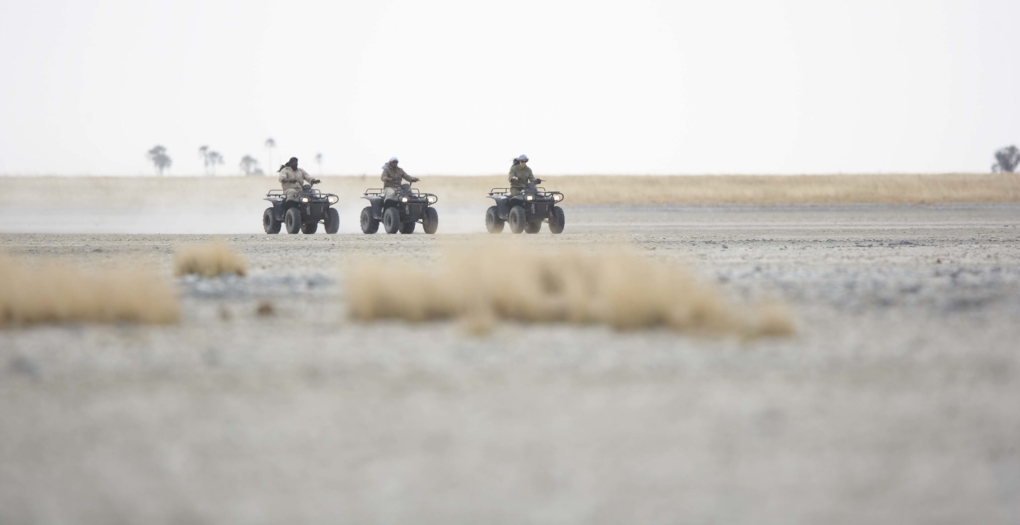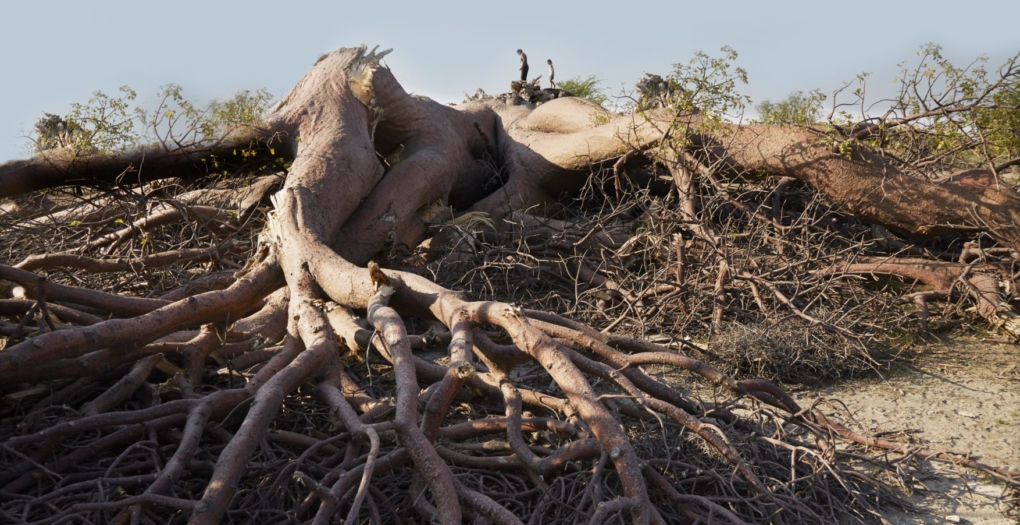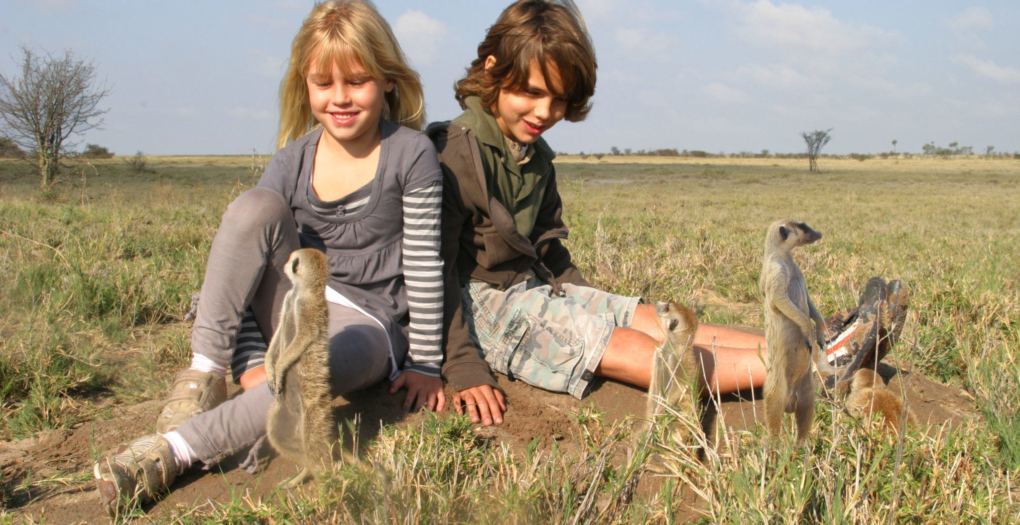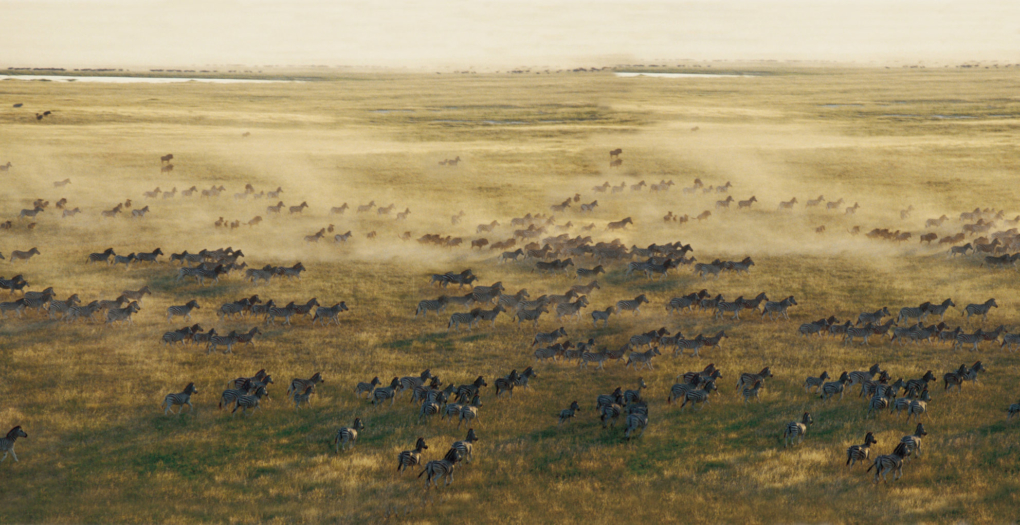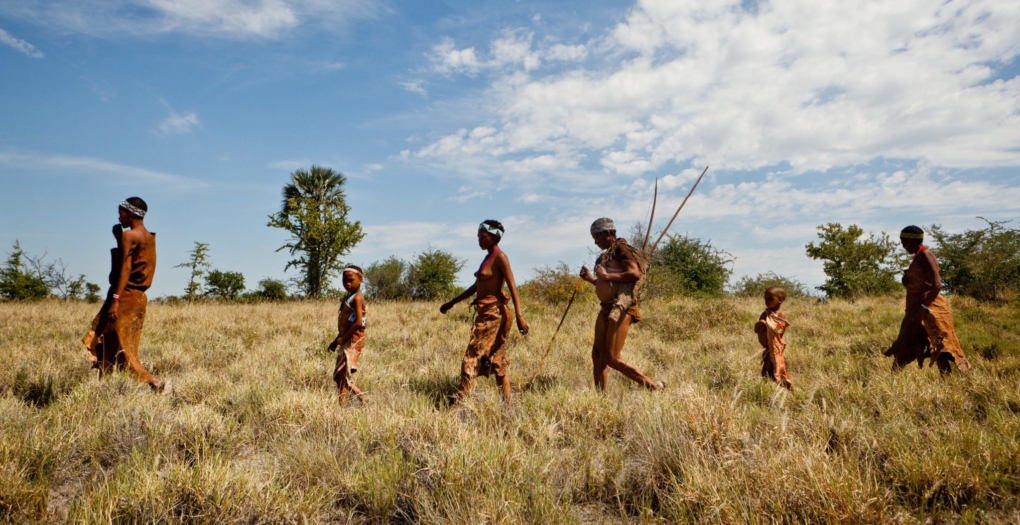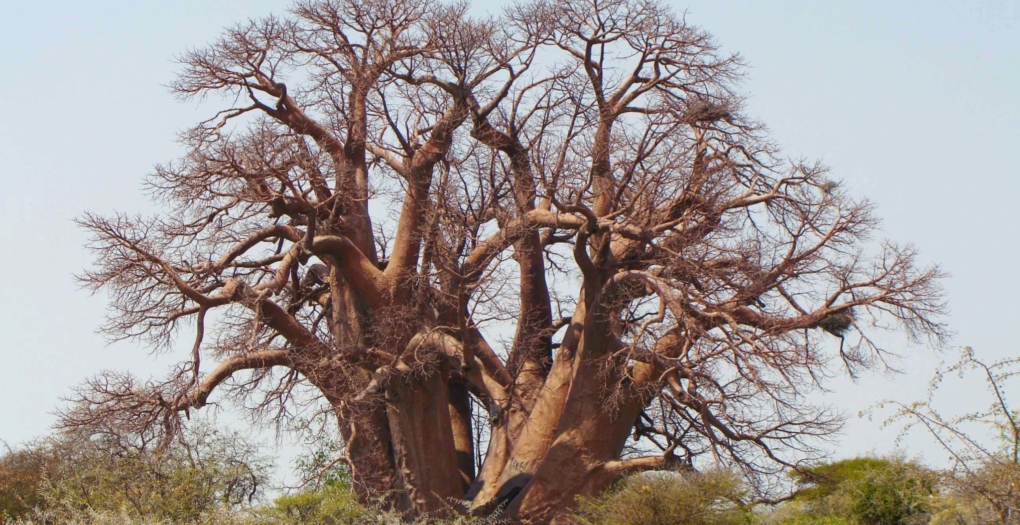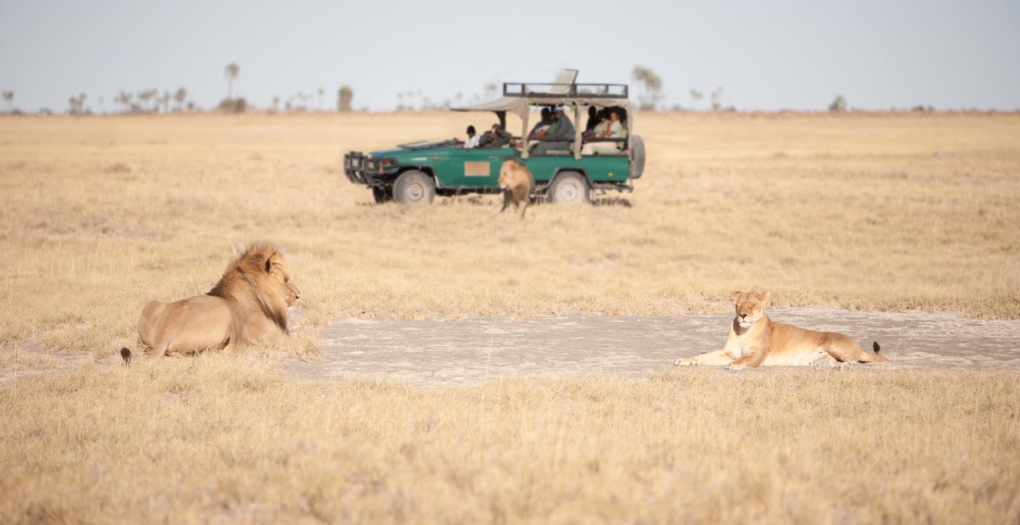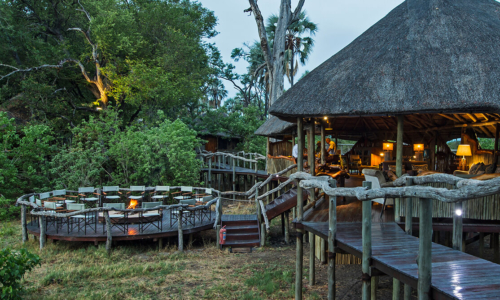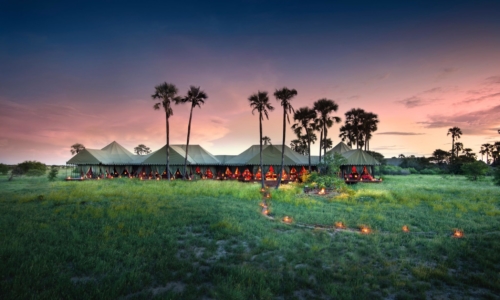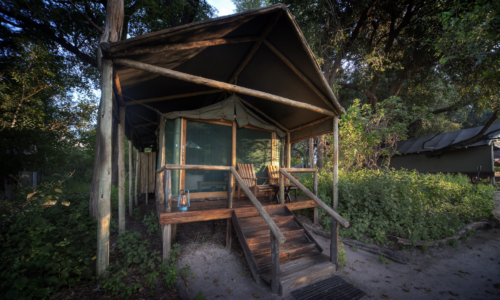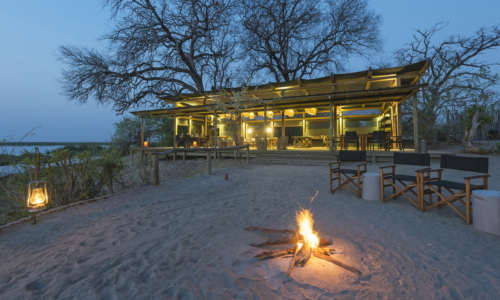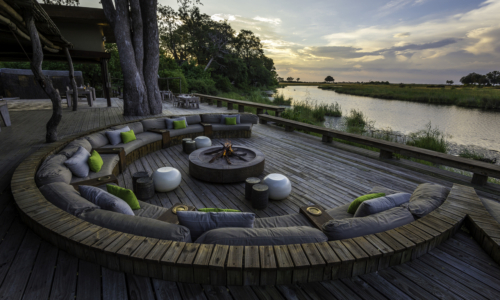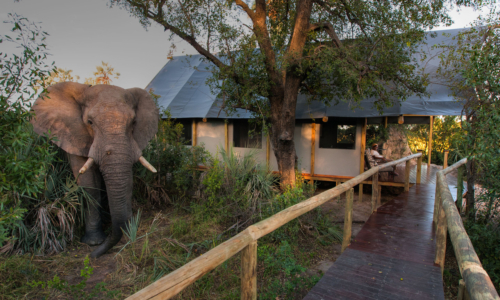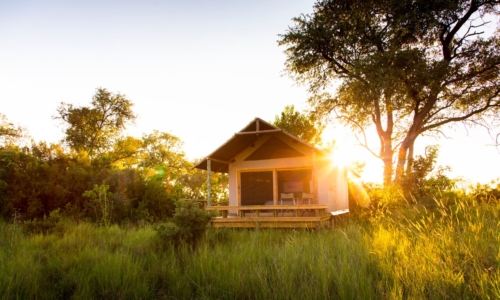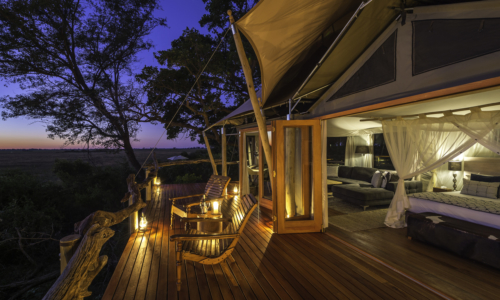The enormous salt pan is all that is left of Lake Makgadikgadi which once covered an area larger than Switzerland, but has since dried up several thousand years ago. The pan is southeast of the Okavango Delta and surrounded by the Kalahari Desert and cover 6,200-square miles. Makgadikgadi is actually made up of several salt pans with sandy desert in between with the three largest being Sowa, Nwetwe, and Nxai. Most of the year, the pans are dry, salty clay crusts yet during the rainy season, they become covered with water and grass making them a haven for wildlife. The main water source is the Nata River. The pans themselves are salty desert whose only plant life is a thin layer of blue-green algae but are ringed by salt marshes and are home to the unusual baobab trees including the famous Chapman’s Baobab.
During most of the year very little wildlife can live here due to the strong hot winds and only salt water. However, following the rains the area becomes an important habitat for migrating animals including wildebeest and one of Africa’s biggest zebra populations. Of course, their natural predators like the black-maned Kalahari lions, hyenas, and leopards are close behind. The wet season also brings migratory birds to the pans such as ducks, geese, and great white pelicans.
Moreover, the Sowa pan is the home of one of only two breeding populations of greater flamingos in southern Africa. During the dry season, the only birds found here are ostriches, chestnut-banded plover, and Kittlitz’s plover. There are also several reptiles living in the pans such as tortoises, rock monitor, snakes, and lizards including the endemic Makgadikgadi spiny agama. Habituated meerkats can be visited year-round.
Makgadikgadi offers plenty of exciting activities. During the rainy season, when there are lots of migrating herds and their predators around, game drives are a popular pastime. The local lodges and safari camps offer daily game drives in 4WD vehicles conducted by an expert guide. For an even more unique and authentic experience, nature walks with the local San Bushmen are the best way to learn about the flora and the fauna of the area as well as tracking skills. Once the water dries up, the real fun begins. The flat salt pans are perfect for quad bikes tours. These adrenaline-pumping adventures can be just for a day or longer with camping involved. Horseback safaris also take advantage of the flat pans, perfect for galloping to picturesque places like Baines’ Baobabs.


- Atzaro Okavango
- Baines’ Lodge
- Camp Kalahari
- Camp Moremi
- Camp Okavango
- Camp Xakanaxa
- Chief’s Camp
- Chitabe Camp
- Chitabe Lediba Camp
- Chobe Chilwero
- Chobe Game Lodge
- Chobe Under Canvas
- Dinaka
- Duba Explorers Camp
- Duba Plains Camp
- Duke’s Camp
- DumaTau Camp
- Eagle Island Lodge
- Elela
- Elephant Pan
- Gomoti Plains Camp
- Gomoti Private
- Gunn’s Camp
- Jacana Camp
- Jack’s Camp
- Jao Camp
- Kalahari Plains Camp
- Kanana
- Karangoma
- Khwai Leadwood
- Khwai Lediba
- King’s Pool Camp
- Kiri Camp
- Kubu Lodge
- Kwara Camp
- Kwetsani Camp
- Lagoon Camp
- Lebala Camp
- Leroo La Tau
- Linyanti Bush Camp
- Linyanti Ebony
- Linyanti Tented Camp
- Little DumaTau
- Little Kwara Camp
- Little Machaba
- Little Mombo Camp
- Little Sable
- Little Tubu Camp
- Little Vumbura Camp
- Machaba Camp
- Mashatu Euphorbia Villas
- Mashatu Lodge
- Mashatu Tented Camp
- Maxa Camp
- Mbamba
- Meno A Kwena
- Migration Expeditions
- Mokete Camp
- Mokolwane
- Mombo Camp
- Monachira Camp
- Moremi Crossing
- Muchenje Safari Lodge
- Ngoma Safari Lodge
- North Island Okavango
- Nxabega Okavango Tented Camp
- Nxai Pan Camp
- Nxamaseri Island Lodge
- Okavango Explorers Camp
- Okuti
- Pelo Camp
- Planet Baobab
- Pom Pom Camp
- Qorokwe Camp
- Sable Alley
- San Camp
- Sandibe Okavango Safari Lodge
- Savute Elephant Lodge
- Savute Safari Lodge
- Savute Under Canvas
- Savuti Camp
- Selinda Camp
- Selinda Explorers Camp
- Shinde
- Shinde Enclave
- Sitatunga Private Island
- Skybeds
- Splash Camp
- Stanley’s Camp
- Tau Pan Camp
- Tawana
- Thamo Telele
- Tubu Tree Camp
- Tuli Safari Lodge
- Tuludi
- Vumbura Plains Camp
- Xaranna Camp
- Xigera Safari Lodge
- Xudum Okavango Delta Lodge
- Xugana Island Lodge
- Zarafa Camp
- Atzaro Okavango
- Baines’ Lodge
- Camp Kalahari
- Camp Moremi
- Camp Okavango
- Camp Xakanaxa
- Chief’s Camp
- Chitabe Camp
- Chitabe Lediba Camp
- Chobe Chilwero
- Chobe Game Lodge
- Chobe Under Canvas
- Dinaka
- Duba Explorers Camp
- Duba Plains Camp
- Duke’s Camp
- DumaTau Camp
- Eagle Island Lodge
- Elela
- Elephant Pan
- Gomoti Plains Camp
- Gomoti Private
- Gunn’s Camp
- Jacana Camp
- Jack’s Camp
- Jao Camp
- Kalahari Plains Camp
- Kanana
- Karangoma
- Khwai Leadwood
- Khwai Lediba
- King’s Pool Camp
- Kiri Camp
- Kubu Lodge
- Kwara Camp
- Kwetsani Camp
- Lagoon Camp
- Lebala Camp
- Leroo La Tau
- Linyanti Bush Camp
- Linyanti Ebony
- Linyanti Tented Camp
- Little DumaTau
- Little Kwara Camp
- Little Machaba
- Little Mombo Camp
- Little Sable
- Little Tubu Camp
- Little Vumbura Camp
- Machaba Camp
- Mashatu Euphorbia Villas
- Mashatu Lodge
- Mashatu Tented Camp
- Maxa Camp
- Mbamba
- Meno A Kwena
- Migration Expeditions
- Mokete Camp
- Mokolwane
- Mombo Camp
- Monachira Camp
- Moremi Crossing
- Muchenje Safari Lodge
- Ngoma Safari Lodge
- North Island Okavango
- Nxabega Okavango Tented Camp
- Nxai Pan Camp
- Nxamaseri Island Lodge
- Okavango Explorers Camp
- Okuti
- Pelo Camp
- Planet Baobab
- Pom Pom Camp
- Qorokwe Camp
- Sable Alley
- San Camp
- Sandibe Okavango Safari Lodge
- Savute Elephant Lodge
- Savute Safari Lodge
- Savute Under Canvas
- Savuti Camp
- Selinda Camp
- Selinda Explorers Camp
- Shinde
- Shinde Enclave
- Sitatunga Private Island
- Skybeds
- Splash Camp
- Stanley’s Camp
- Tau Pan Camp
- Tawana
- Thamo Telele
- Tubu Tree Camp
- Tuli Safari Lodge
- Tuludi
- Vumbura Plains Camp
- Xaranna Camp
- Xigera Safari Lodge
- Xudum Okavango Delta Lodge
- Xugana Island Lodge
- Zarafa Camp

The enormous salt pan is all that is left of Lake Makgadikgadi which once covered an area larger than Switzerland, but has since dried up several thousand years ago. The pan is southeast of the Okavango Delta and surrounded by the Kalahari Desert and cover 6,200-square miles. Makgadikgadi is actually made up of several salt pans with sandy desert in between with the three largest being Sowa, Nwetwe, and Nxai. Most of the year, the pans are dry, salty clay crusts yet during the rainy season, they become covered with water and grass making them a haven for wildlife. The main water source is the Nata River. The pans themselves are salty desert whose only plant life is a thin layer of blue-green algae but are ringed by salt marshes and are home to the unusual baobab trees including the famous Chapman’s Baobab.
During most of the year very little wildlife can live here due to the strong hot winds and only salt water. However, following the rains the area becomes an important habitat for migrating animals including wildebeest and one of Africa’s biggest zebra populations. Of course, their natural predators like the black-maned Kalahari lions, hyenas, and leopards are close behind. The wet season also brings migratory birds to the pans such as ducks, geese, and great white pelicans.
Moreover, the Sowa pan is the home of one of only two breeding populations of greater flamingos in southern Africa. During the dry season, the only birds found here are ostriches, chestnut-banded plover, and Kittlitz’s plover. There are also several reptiles living in the pans such as tortoises, rock monitor, snakes, and lizards including the endemic Makgadikgadi spiny agama. Habituated meerkats can be visited year-round.
Makgadikgadi offers plenty of exciting activities. During the rainy season, when there are lots of migrating herds and their predators around, game drives are a popular pastime. The local lodges and safari camps offer daily game drives in 4WD vehicles conducted by an expert guide. For an even more unique and authentic experience, nature walks with the local San Bushmen are the best way to learn about the flora and the fauna of the area as well as tracking skills. Once the water dries up, the real fun begins. The flat salt pans are perfect for quad bikes tours. These adrenaline-pumping adventures can be just for a day or longer with camping involved. Horseback safaris also take advantage of the flat pans, perfect for galloping to picturesque places like Baines’ Baobabs.

- Atzaro Okavango
- Baines’ Lodge
- Camp Kalahari
- Camp Moremi
- Camp Okavango
- Camp Xakanaxa
- Chief’s Camp
- Chitabe Camp
- Chitabe Lediba Camp
- Chobe Chilwero
- Chobe Game Lodge
- Chobe Under Canvas
- Dinaka
- Duba Explorers Camp
- Duba Plains Camp
- Duke’s Camp
- DumaTau Camp
- Eagle Island Lodge
- Elela
- Elephant Pan
- Gomoti Plains Camp
- Gomoti Private
- Gunn’s Camp
- Jacana Camp
- Jack’s Camp
- Jao Camp
- Kalahari Plains Camp
- Kanana
- Karangoma
- Khwai Leadwood
- Khwai Lediba
- King’s Pool Camp
- Kiri Camp
- Kubu Lodge
- Kwara Camp
- Kwetsani Camp
- Lagoon Camp
- Lebala Camp
- Leroo La Tau
- Linyanti Bush Camp
- Linyanti Ebony
- Linyanti Tented Camp
- Little DumaTau
- Little Kwara Camp
- Little Machaba
- Little Mombo Camp
- Little Sable
- Little Tubu Camp
- Little Vumbura Camp
- Machaba Camp
- Mashatu Euphorbia Villas
- Mashatu Lodge
- Mashatu Tented Camp
- Maxa Camp
- Mbamba
- Meno A Kwena
- Migration Expeditions
- Mokete Camp
- Mokolwane
- Mombo Camp
- Monachira Camp
- Moremi Crossing
- Muchenje Safari Lodge
- Ngoma Safari Lodge
- North Island Okavango
- Nxabega Okavango Tented Camp
- Nxai Pan Camp
- Nxamaseri Island Lodge
- Okavango Explorers Camp
- Okuti
- Pelo Camp
- Planet Baobab
- Pom Pom Camp
- Qorokwe Camp
- Sable Alley
- San Camp
- Sandibe Okavango Safari Lodge
- Savute Elephant Lodge
- Savute Safari Lodge
- Savute Under Canvas
- Savuti Camp
- Selinda Camp
- Selinda Explorers Camp
- Shinde
- Shinde Enclave
- Sitatunga Private Island
- Skybeds
- Splash Camp
- Stanley’s Camp
- Tau Pan Camp
- Tawana
- Thamo Telele
- Tubu Tree Camp
- Tuli Safari Lodge
- Tuludi
- Vumbura Plains Camp
- Xaranna Camp
- Xigera Safari Lodge
- Xudum Okavango Delta Lodge
- Xugana Island Lodge
- Zarafa Camp
- Atzaro Okavango
- Baines’ Lodge
- Camp Kalahari
- Camp Moremi
- Camp Okavango
- Camp Xakanaxa
- Chief’s Camp
- Chitabe Camp
- Chitabe Lediba Camp
- Chobe Chilwero
- Chobe Game Lodge
- Chobe Under Canvas
- Dinaka
- Duba Explorers Camp
- Duba Plains Camp
- Duke’s Camp
- DumaTau Camp
- Eagle Island Lodge
- Elela
- Elephant Pan
- Gomoti Plains Camp
- Gomoti Private
- Gunn’s Camp
- Jacana Camp
- Jack’s Camp
- Jao Camp
- Kalahari Plains Camp
- Kanana
- Karangoma
- Khwai Leadwood
- Khwai Lediba
- King’s Pool Camp
- Kiri Camp
- Kubu Lodge
- Kwara Camp
- Kwetsani Camp
- Lagoon Camp
- Lebala Camp
- Leroo La Tau
- Linyanti Bush Camp
- Linyanti Ebony
- Linyanti Tented Camp
- Little DumaTau
- Little Kwara Camp
- Little Machaba
- Little Mombo Camp
- Little Sable
- Little Tubu Camp
- Little Vumbura Camp
- Machaba Camp
- Mashatu Euphorbia Villas
- Mashatu Lodge
- Mashatu Tented Camp
- Maxa Camp
- Mbamba
- Meno A Kwena
- Migration Expeditions
- Mokete Camp
- Mokolwane
- Mombo Camp
- Monachira Camp
- Moremi Crossing
- Muchenje Safari Lodge
- Ngoma Safari Lodge
- North Island Okavango
- Nxabega Okavango Tented Camp
- Nxai Pan Camp
- Nxamaseri Island Lodge
- Okavango Explorers Camp
- Okuti
- Pelo Camp
- Planet Baobab
- Pom Pom Camp
- Qorokwe Camp
- Sable Alley
- San Camp
- Sandibe Okavango Safari Lodge
- Savute Elephant Lodge
- Savute Safari Lodge
- Savute Under Canvas
- Savuti Camp
- Selinda Camp
- Selinda Explorers Camp
- Shinde
- Shinde Enclave
- Sitatunga Private Island
- Skybeds
- Splash Camp
- Stanley’s Camp
- Tau Pan Camp
- Tawana
- Thamo Telele
- Tubu Tree Camp
- Tuli Safari Lodge
- Tuludi
- Vumbura Plains Camp
- Xaranna Camp
- Xigera Safari Lodge
- Xudum Okavango Delta Lodge
- Xugana Island Lodge
- Zarafa Camp







